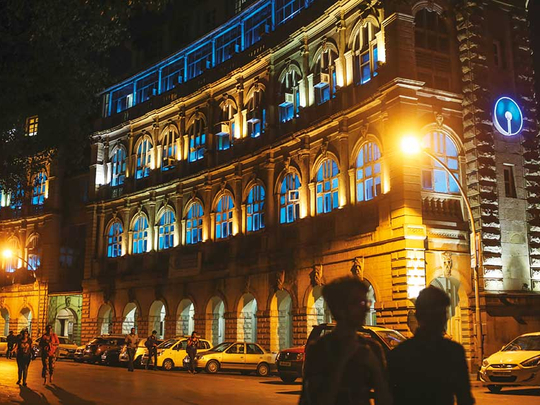
Dubai: Adversely impacted on both supply and demand side, slow credit growth will be a major challenge for India’s post-pandemic economic recovery, according to bankers, economists and analysts.
In addition to slowing credit growth, the economy faces on hurdles on multiple fronts including rising inflation, slowing demand and weak consumer sentiments.
At the core of the economic woes lie the rising caution among banks in lending following the second wave of COVID-19. Aggregate credit at Indian commercial banks grew 5.6 per cent year over year in the quarter ended March 31, the slowest rate since the second quarter of 2017, according to data released by the Reserve Bank of India (RBI), on May 28. Aggregate deposits in the March quarter expanded at 12.3 per cent year over year, the fastest pace of quarterly growth since 2017.
Fear of impairments
Credit growth at India's commercial banks is likely to recover gradually in 2021, rather than quickly, as the country emerges from a deadly wave of COVID-19 and struggles to vaccinate the world's second-biggest population, credit rating agency Standard & Poor’s said in a recent report.
India’s banks in general have turned cautious after a sharp rise in loan defaults following the first and second wave of the pandemic. The RBI expects banks' bad loan ratio to jump to 9.8 per cent by the end of this financial year from 7.48 per cent a year ago.
Analysts fear that tightened lending by banks could nullify a majority of the government’s pandemic relief schemes that heavily rely on higher lending by individuals and businesses.
With pressure on asset quality and credit growth remaining in the range of 5-5.7 per cent, the industry is set to report muted earnings for the first quarter of 2022 (Q1 FY22).
“Private banks, with healthy capitalisation, may grow at 8-10%, gaining market share from public banks. Sequentially, the growth is expected to be muted at 1-2% as the first quarter is generally a slow quarter and lockdowns have further added pressure,” analysts at ICICI Direct said.
A number of banks have already disclosed provisional estimates on key business parameters for the quarter ended June 2021, which reflects lower retail disbursement primarily due to the adverse impact of the second wave, resulting in the outstanding retail loan book to contact.
For instance, India’s most valuable lender HDFC Bank has seen a 30% quarter-on-quarter contraction in retail disbursement. In absolute terms, disbursements stood at Rs436 billion, lower than Rs62,5 billion disbursed during the previous quarter, as per provisional data. In the case of Yes Bank, retail disbursement fell 34.86 per cent in the June quarter over the March-ended quarter, leaving a dent on the overall loan book.
“Business activity was impacted over April-May and we believe Q1 FY22 to be a quarter of consolidation as the momentum in recovery gained over Q4 FY21 was impacted by the second wave, with the asset quality outlook deteriorating once again. While economic activity has started to pick up since June, we expect business growth to remain modest over Q1 FY22 and estimate systemic loan growth of 9% for FY22. Growth in working capital requirements in the corporate segment would be another monitorable,” wrote analysts at Motilal Oswal in a note.
Slowing credit demand and deleveraging
While banks are hesitant to lend on the one hand, companies are pushing back investment plans amid lack of demand on the other.
Corporate willingness for new investments is low, according to the Centre for Monitoring Indian Economy Pvt., with capital expenditure declining. While companies have posted bumper profits mostly on the back of widespread cost cutting, most have used the extra funds generated to pay down bank loans.
According to a recent research from State Bank of India, India's largest public sector bank, more than 1.7 trillion rupees ($22.8 billion) worth of debt was pared last year. Refineries, steel, fertilizers, mining and mineral products as well as textile companies alone reduced debt by more than 1.5 trillion rupees, with the trend continuing this year, the bank’s chief economist Soumya Kanti Ghosh wrote in a note.
Several large companies deleveraged by repaying costly loans with funds raised from bond sales. India's private sector banks have grown their credit faster than their state-run peers. Aggregate credit at private sector banks rose 9.1 per cent year over year in the March quarter, compared with a 3.6 per cent increase at their public sector counterparts. Deposit growth followed a similar trajectory.
Gradual credit growth
CRISIL, an Indian unit of S&P Global Inc., said in a recent report that it expects bank credit to grow in a 9 per cent to 10 per cent range for the fiscal year that started April 1. Fiscal support measures, such as enhanced spending and a credit guarantee plan announced by the government, combined with easy monetary policy, will support growth, CRISIL said.
Retail, agriculture and small- and medium-scale sectors will likely drive credit growth for banks, said Krishnan Sitaraman, senior director at CRISIL. "Corporate credit growth, while being expected to be better than last fiscal year, will still be muted as capex [capital expenditure] revival, which drives corporate credit growth, is still some way away, and in the interim many corporates are consolidating and deleveraging," he said.
Lack of credit lending by banks could directly impact demand and economic growth. At the moment, many individuals and businesses are seeking loans to either reshape finances or stabilise operations.
In the absence of retail and small-ticket loans, consumer demand could remain subdued for a longer period, leading to slower economic recovery.
Despite the overall slowdown, credit deployment at the medium-sized enterprises, housing, auto and personal loans segments remained robust during the fiscal year ended March 31, according to the RBI data. Credit deployment at medium-sized enterprises was up 28.8 per cent during the fiscal year, while housing credit saw 9.1 per cent growth. Personal loans rose 10.2 per cent.








